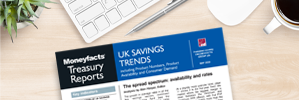Rachel Springall, Finance Expert at Moneyfacts, said:
“Savers may have assumed with the Bank of England Base Rate falling, there would be a bigger impact on the pool of deals able to beat BBR, but that’s not true. In July, only one in 10 of standard savings accounts (10%) could beat 4.25%, and with a 0.25% cut made in August, that’s only improved slightly to one in four, or 26% of all accounts paying more than 4%. This means the majority of savings accounts fail to beat BBR. As inflation is expected to climb higher, this means the vast majority of savers will see their pots eroded in real terms. This will be incredibly demoralising for savers who use their interest to supplement their income, and in fact, the situation has been dire for many years. Indeed, savers would need to cast their eyes back to the start of August 2022 to find the last time that more than half of the savings market could beat BBR, when 56% could do so, but the rate to beat was just 1.25%. The rate of inflation back then was abysmal, as it rose to double digits, so it was a terrible situation for savers.
“As may be expected, savers are casualties of base rate cuts, and over the past month we have seen variable rates tumble. The average easy access rate has dropped to 2.59%, so there will be many savers out there losing money in real terms due to inflation. Variable savings rates are now all at their lowest levels for two years (July 2023), back when base rate was 5%. Those savers who want to secure a guaranteed return on their cash may be wise to lock into a fixed bond or cash ISA. Luckily for savers the choice of cash ISAs overall continues to rise, reaching another record high. Those who have yet to utilise their ISA allowance would be wise to do so, especially if savers fear a cut to the allowance could be announced in the Budget, so savers will no doubt want to maximise their deposits in the meantime.
“Savings providers typically offer more attractive returns to savers who are prepared to lock their cash away for an agreed time, such as with a fixed rate bond or notice account, and less so for accounts where the cash could be instantly withdrawn. Amid the uncertainty surrounding the future of interest rates, savers are already showing their keenness in interest-bearing time deposits, according to the Bank of England. In fact, deposits more than trebled in the space of a month to £4.3bn during July, up from £1.2bn the month prior, and the highest monthly deposit since January 2025, of £5.8bn. Locking into a guaranteed return with a fixed bond amid tumbling variable rates is wise, but savers must be aware of their Personal Savings Allowance (PSA), which in itself, could be reviewed or abolished in the future by the Government.”
Rachel Springall, Finance Expert at Moneyfacts, said:
“Savers may have assumed with the Bank of England Base Rate falling, there would be a bigger impact on the pool of deals able to beat BBR, but that’s not true. In July, only one in 10 of standard savings accounts (10%) could beat 4.25%, and with a 0.25% cut made in August, that’s only improved slightly to one in four, or 26% of all accounts paying more than 4%. This means the majority of savings accounts fail to beat BBR. As inflation is expected to climb higher, this means the vast majority of savers will see their pots eroded in real terms. This will be incredibly demoralising for savers who use their interest to supplement their income, and in fact, the situation has been dire for many years. Indeed, savers would need to cast their eyes back to the start of August 2022 to find the last time that more than half of the savings market could beat BBR, when 56% could do so, but the rate to beat was just 1.25%. The rate of inflation back then was abysmal, as it rose to double digits, so it was a terrible situation for savers.
“As may be expected, savers are casualties of base rate cuts, and over the past month we have seen variable rates tumble. The average easy access rate has dropped to 2.59%, so there will be many savers out there losing money in real terms due to inflation. Variable savings rates are now all at their lowest levels for two years (July 2023), back when base rate was 5%. Those savers who want to secure a guaranteed return on their cash may be wise to lock into a fixed bond or cash ISA. Luckily for savers the choice of cash ISAs overall continues to rise, reaching another record high. Those who have yet to utilise their ISA allowance would be wise to do so, especially if savers fear a cut to the allowance could be announced in the Budget, so savers will no doubt want to maximise their deposits in the meantime.
“Savings providers typically offer more attractive returns to savers who are prepared to lock their cash away for an agreed time, such as with a fixed rate bond or notice account, and less so for accounts where the cash could be instantly withdrawn. Amid the uncertainty surrounding the future of interest rates, savers are already showing their keenness in interest-bearing time deposits, according to the Bank of England. In fact, deposits more than trebled in the space of a month to £4.3bn during July, up from £1.2bn the month prior, and the highest monthly deposit since January 2025, of £5.8bn. Locking into a guaranteed return with a fixed bond amid tumbling variable rates is wise, but savers must be aware of their Personal Savings Allowance (PSA), which in itself, could be reviewed or abolished in the future by the Government.”








